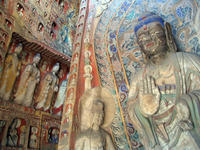You are in: Asia -> China -> Yungang Grottoes, and traditional search or Image Gallery will yield results of this site only
Yungang Grottoes
| Site number: | 1039 |
|
| Type of site: | Cultural | |
| Date: | 5-6th centuries | |
| Date of Inscription: | 2001 | |
| Location: | Asia, China, China, Datong City, Shanxi Province | |
Up to 75 images are shown here. Click on each for more details or on Image Gallery for more images.
| Description: | The Yungang Grottoes (located in Datong city, Shanxi Province) incorporate their 252 caves and 51,000 statues, collectively representing China’s exceptional achievement of Buddhist cave art in the 5th and 6th centuries. Tan Yao’s created Five Caves hold a strict unity of layout and design, constituting a classical masterpiece of the first peak of Chinese Buddhist art. --WHMNet paraphrase from the description at WHC Site, where additional information is available. For 360 degree imaging of this site, click here. | |
| The Yungang Grottoes (simplified Chinese: 云冈石窟; traditional Chinese: 雲崗石窟; pinyin: Yúngāng Shíkū) are ancient Buddhist temple grottoes near the city of Datong in the Chinese province of Shanxi. They are excellent examples of rock-cut architecture and one of the three most famous ancient sculptural sites of China. The others are Longmen and Mogao.The site is located about 16 km south-west of the city, in the valley of the Shi Li river at the base of the Wuzhou Shan mountains. The grottoes were mainly constructed in the period between 460-525 AD during the Northern Wei dynasty. They are an outstanding example of the Chinese stone carvings from the 5th and 6th centuries. All together the site is composed of 252 grottoes with more than 51,000 Buddha statues and statuettes. In 2001, the Yungang Grottoes were made a UNESCO World Heritage Site The Yungang Grottoes is considered by UNESCO a "masterpiece of early Chinese Buddhist cave art... [and] ...represent the successful fusion of Buddhist religious symbolic art from south and central Asia with Chinese cultural traditions, starting in the 5th century CE under Imperial auspices." After the decline of the Jin Dynasty, the northern parts of China came under the control of the Northern Wei dynasty, emerging from a proto-mongolic tribe called Tuoba. They made the city of Pingcheng, now known as Datong, their capital. Due to its promotion, Pingcheng saw an increase in construction work. The Northern Wei early adopted Buddhism as their state religion. Buddhism arrived in this location via travel on the ancient North Silk Road, the northernmost route of about 2600 kilometres in length, which connected the ancient Chinese capital of Xian to the west over the Wushao Ling Pass to Wuwei and emerging in Kashgar before linking to ancient Parthia. --Wikipedia. Text is available under the Creative Commons Attribution-ShareAlike License. For 360 degree imaging of this site, click here. | ||
| Source: | http://whc.unesco.org/en/list/1039 | |
| Reference: | 1. UNESCO World Heritage Center, Site Page. | |












































































